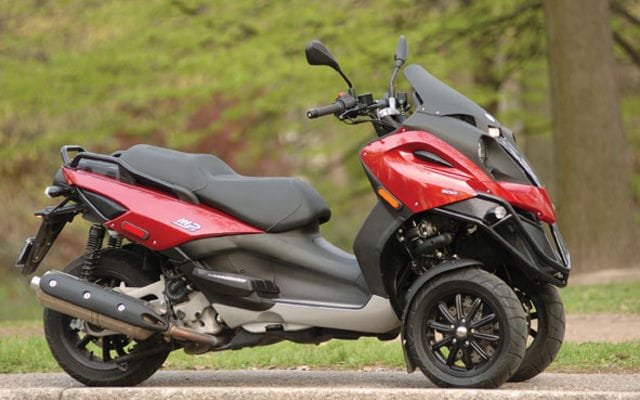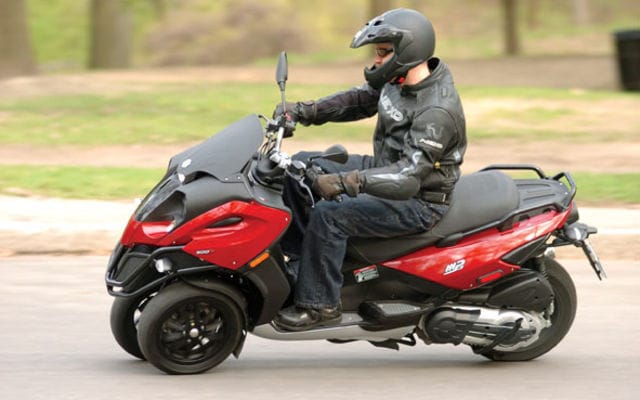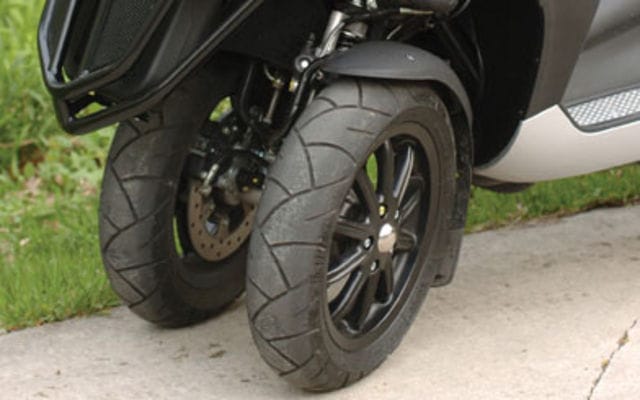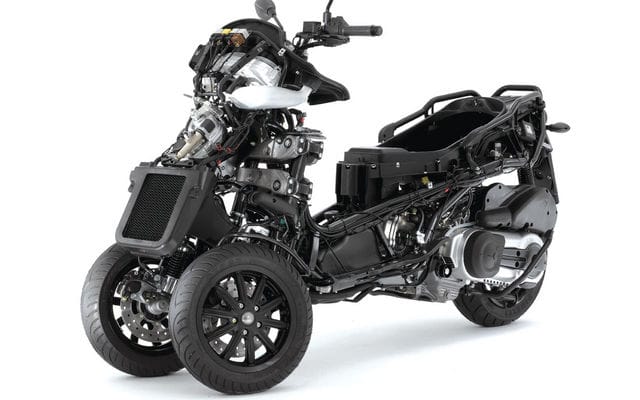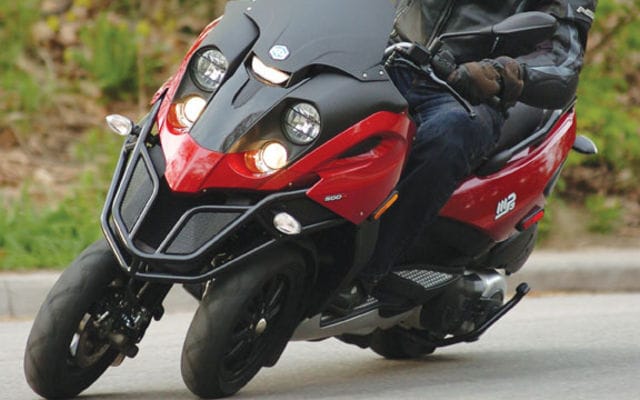It has been a year since we tested Piaggio’s MP3, an innovative 250 cc scooter that dared to add a third wheel and upset the balance of traditionalists in the process. New for 2008, Piaggio has expanded the MP3 line to include 400 and 500 cc variants, transforming an urban crawler into an urban brawler.
It’s impossible to overlook the dramatic restyling of the 250’s bodywork as fitted on the MP3 500 we test here. This largest MP3 is marketed in Canada under the Piaggio nameplate, but is in fact a rebadged Gilera Fuoco 500ie—the reason behind the masquerade being that the Piaggio nameplate is more familiar over here. The MP3’s tough visage dares anyone to step into its path; with a glaring array of headlights and a tubular steel push bar, it’s more military assault vehicle than eco-friendly transport.
The list of anomalies bundled in every MP3 is impressive. The parallelogram front suspension’s four -aluminium arms with supporting steering tubes keeps the stationary machine upright when the hydraulic system is locked, but don’t forget the switch, as it will topple over just like any other two wheeler if you do or if you’re not mindful of the switch’s location. We barely averted catastrophe while switching riders when the departing rider inadvertently bumped the handlebar switch and unlocked the suspension. It was only by chance that the other rider managed to catch the falling scooter when he heard the warning beeping of an unlocking suspension.
While there is some amusement to be found in locking the system upright while stopping for a traffic light, it quickly becomes tiresome, as you must carefully time its engagement. The mechanism only becomes available at very low speeds and a slow reaction time will result in an embarrassing lock in a partial lean. In the end we preferred to use the traditional foot down approach, as you would on a normal two-wheeler, and ultimately it is the safer choice.
Pressing the starter immediately fires the liquid-cooled, four-valve, fuel-injected 493 cc single. But idle is rough for several minutes before the ECU can settle the warm-up to a fast idle. Once underway, noise levels, even at full throttle, were never a concern. The combination of a rear-mounted engine and low-mounted exhaust with large capacity canister allowed the distinctive sound of a thumper to be heard without it becoming tiresome.
An additional 18 hp over the 250 (Cycle Canada, June 2007) boosts claimed power up to 40 hp at 7,250 rpm. The 500’s CV transmission displayed none of the off-idle hesitation that was a complaint of the 250, and its power cleanly pulls the weighty 244 kg (538 lb) scooter from traffic lights with authority. We did, however, find an optimistic speedometer. At an indicated 50 km/h the MP3 was measured by GPS to be going 45.6 km/h, while 100 km/h proved to be a real world 92 km/h. Like the old trick of setting the time on your alarm clock ahead to make sure you get up in time, the speedometer’s inaccuracy, if forgotten, may prevent speeding tickets.
Top speed was a deficiency of the 250, as highway speeds could barely be maintained. While the increased displacement of the 500 has adequately addressed this problem, there isn’t a lot left over for passing. Overtaking from a speed over 100 km/h requires forethought and caution—the 500 pulls progressively up to its top speed of an actual 130 km/h (149 km/h indicated) but not fast enough to leave room for error. Not that any additional speed would be useable. The deceptively large frontal surface of the MP3 does little to divert windblast from the rider’s upper body, and at highway speeds it’s similar to riding a naked bike. Although the brunt of the wind’s force hits mid-chest (for a six foot rider), airflow was clean and free from turbulence or helmet buffeting. The same can’t be said for the low-pressure area at the rider’s feet and legs, where the turbulence was enough to partly shred a plastic grocery bag being used to test the legitimacy of the bag hook.
Piaggio justifies its radical three-wheel layout as a safety feature, and claims a 40-degree lean angle for the 500. With those twin front wheels were we dutifully tempted to explore those limits, and found left turns caused us to touch down the centre stand tong. While the obvious benefit of having a second front wheel is to add traction in aggressive leaning and extra stability when turning on less than ideal road conditions, braking is also greatly helped. The MP3 500 retains the dual front 240 mm floating rotors with twin piston calipers of the 250, but increases the rear rotor diameter 40 mm to 280 mm. This means that the MP3 will stop as hard as you can pull in the handlebar mounted levers.
Intentionally trying to upset the scooter by locking up the rear or front wheels does little damage; the rear only hinted at a slight weave, while the front continued to track straight. One feature that we would have liked to see standard was adjustable brake levers. Riders with small hands will find the long reach to the brake levers made worse by a short engagement point when they’re pulled. Even those of us with larger hands found it difficult to precisely modulate their use; the rear brake felt wooden, and though the front was better, it also lacked a progressive feel.
While we were impressed with the 250’s ability to maintain its composure over everything put in its path, the same can’t be said of the 500, which hammered its way across defects in the road’s surface, in a few cases bucking our heaviest tester from the seat. The suspension strains under the weight of the heavier 500 (40 kg/88 lb over the 250). By softening the rear suspension’s four-position preload (the front is not adjustable), lowering front tire pressure from the as-delivered 32 psi to 26 psi and the rear from 37 psi to 33 psi, as recommended in the owner’s manual, made a noticeable improvement in the MP3’s compliance, however the ride remained harsh.
More disconcerting than the harsh ride was the Piaggio’s seat. With a height of 785 mm (31 in.) and a wide floorboard which forces legs to be splayed apart to reach the ground, it takes a long pair of legs to keep both feet planted flat at a stop. The somewhat cramped cabin forced taller riders to sit back into the hump that divides the rider’s seat area from the passenger’s seat area, putting pressure on the tailbone. Those short on commutes or stature might not find this to be a sore point, but on extended rides, something that the larger MP3 seems to be designed for, it caused a great deal of discomfort for one tester. When we raised the issue with the MP3’s importer, Canadian Scooter Corporation, it was clear that this was a common complaint. Piaggio has apparently already addressed the seating issue, and we were told that a replacement comfort seat would soon be available. In the interim, Canadian Scooter Corporation has found another solution. Its in-house upholsterer removes the seat skin and shaves down the seat foam before inserting a layer of memory foam.
There is a strong practical appeal to the 500; pressing a fob type button on the ignition key unlocks the seat and tipping it forward accesses an under-seat storage compartment. It has a smaller storage capacity than the 250, a necessary concession to the larger displacement motor, but to compensate, there’s a small parcel rack behind the passenger seat surrounded by robust grab handles. Between the rider’s legs is the traditional shopping bag hook found on other Piaggios and Vespas. One tester felt that only a cup holder was missing from the arrangement, which would allow him to sip his grande, non-fat, no-foam latte while waiting for the light to change.
Those out after dark will appreciate the MP3’s highly visible lighting. The high beams when tested displayed a strange photometric pattern: on a street void of supplementary lighting they gave the appearance of shining a light through the opening of a tube, projecting a circular path of light far down the road.
Cleanly laid out instrumentation, with chromed bezels around an analogue speedometer and tachometer with gas gauge, flank a digital display that can be manipulated from a handlebar-mounted mode button that cycles the display between trip meters and ambient temperature. The instrumentation was clearly visible at night, although the warning lights were difficult to see in direct sunlight.
It took us a few minutes to find the gas cap for the 12-litre fuel tank, which is accessed by unlocking a flap between the rider’s feet while the key is in the ignition. More difficult was filling the tank without creating a mess; the opening for the tank is only slightly wider than the gas-pump nozzle, making it difficult to monitor the level of rising fuel.
Many that stopped to ask us the cost of the MP3 balked when we quoted the $10,495 price. But when you consider the price puts the 500 in the same range as Suzuki’s Burgman 650 and Honda’s Silver Wing, it begins to make more sense. Arguably the other maxi scooters offer larger displacement motors and bigger wheels, making their ride closer to that of a motorcycle, but they lack the uniqueness and additional safety of the MP3’s third wheel.
The Piaggio distributor claims that the MP3 500 is selling well, primarily to older men with an appreciation for technology. We would venture that those buyers are also extroverted. The combination of an articulating front end and in-your-face styling means that it is impossible to escape attention, especially in downtown Toronto, where the 500 cut a wide swath through an endless field of gaping mouthed bystanders, all for a price thousands less than the exotic supercars that it regularly upstages. Suddenly the price seems more appealing.
From the Saddle
Every unusual vehicle garners a different response. When I drive my yellow VW Bus people point and laugh, when my neighbour’s brother jacks the hydraulics on his pimped-out Impala the demure Asian couple across the street double-lock the front door and peer through the blinds. But neither the Bus nor the Impala have nearly the effect on bystanders as the MP3.
A topless three-breasted woman skipping rope alongside the highway is the only scenario that could top the MP3 for dumbfounding the public. From the outside in it is impossible to understand it, but from the controls it’s perfectly logical. Where the 250 cc model sucked wind at 100 km/h, this 500 cc variant easily kept pace with suicidal 130 km/h Toronto commuters, who kept drifting into my lane with mouths agape.
It’s not cheap and the riding position is still like sitting on a chair with legs a little too short, but there is nothing that makes such quick work of traversing the city as this machine. It floats over potholes and thorough slippery corners that would send a conventional two-wheeler on its ass, and now that it has a hefty bash bar on the front, if it were mine I’d go out looking for Hummers to ram. — Neil Graham
While sitting on Piaggio’s MP3 500 and making notes about my ride, I observed a man crossing the street towards me, but before I could brace myself for the inevitable questions, he openly challenged me. “What’s the point of that?” he asked. As I began to stammer something about the MP3’s ability to lean, he cut me off, “no, that’s a characteristic of it; I want to know why it’s necessary to have three wheels.” My mention of added safety left him unsatisfied, and with a scrunched up face he retreated back into the night.
His argument was not without merit. Does the innovative MP3 500 represent an advance in scooter design, or is it merely a gimmick meant to attract the look-at-me crowd?
I found my answer in riding it. During normal, even spirited use, the additional wheel went unnoticed, yet it had effectively added a measure of safety and boosted my confidence in riding a small-wheeled scooter hard. As a bonus, Piaggio manages this feat while retaining the element most critical to enjoyment of a two-wheeled vehicle: its ability to lean. Considering its versatility in an urban setting, and aptitude at dealing with beaten road surfaces, the MP3 makes all the sense in the world. — Uwe Wachtendorf
